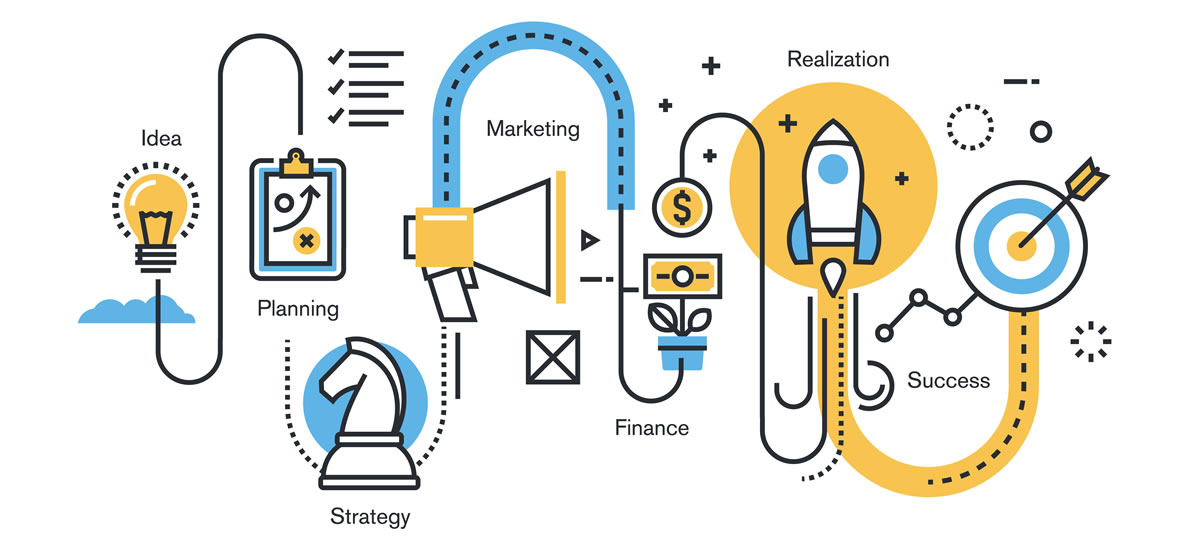Organizations engage in two general business activities to make money. The first is making and selling products/services on a repetitive basis as a part of normal operations. The second is handling new, possibly one-time, projects. So, generally speaking, we can divide an organization’s activity into two categories: operations and projects. Everything that an organization does can be categorized either as a project or process. The number of new projects has greatly increased in most companies because products have a much shorter life cycle due to intense competition and the market pressure for novelty. No organization can survive on the long run if it is focused only on improving its operations. In a competitive business environment, projects play an important role in organizations strategic management. Building a business based on an innovation, can be one of the reasons to initiate projects. But not every project is about creating a new business or innovation.
Projects are vectors for change and for the implementation of strategies and innovations that can bring competitive advantages to companies. (Shenhar and Dvir)
Organizations use project management to achieve operational excellence and planned business growth.
A project can be defined in many ways, including as:

- A unique, transient endeavour, undertaken to achieve planned objectives, which could be defined in terms of outputs, outcomes or benefits.
- One‐time, complex, unique sequence of activities carried out in a project organization with time, and budget constraints and they implement a definite output (project result) (Görög, 2013b).
The optimal project : good, cheap, and fast.
- An organization of people dedicated to a specific purpose or objective. Projects generally involve large, expensive, unique, or high risk undertakings which have to be completed by a certain date, for a certain amount of money, within some expected level of performance. At a minimum, all projects need to have well defined objectives and sufficient resources to carry out all the required tasks.
A project is a problem scheduled for solution.
J. M. Juran
- A collective term for the work performed in turning a given input into an output that had been determined to be of a certain value to the organization.
- A temporary endeavour, having a defined beginning and end (usually constrained by date, but can be by funding or deliverables), undertaken to meet particular goals and objectives, usually to bring about beneficial change or added value.
- The response to a need, the solution to a problem.
- A temporary endeavour undertaken to produce unique product, service, or result. (PMI)
- A temporary endeavour involving a connected sequence of activities and a range of resources, which is designed to achieve a specific and unique outcome and which operates within time, cost and quality constraints and which is often used to introduce change.
- The achievement of a specific objective, which involves a series of activities and tasks which consume resources.
- A novel undertaking or systematic process to create a new product or service, the delivery of which signals completion. Projects involve risk and are typically constrained by limited resources. Max Wideman
Projects are characterized by four features:
The purpose for most projects is to either make money or save money.
- Group of people.
- Goal.
- Limited time and money.
- Certain level of uncertainty regarding whether the goals will be achieved.
Project managers are involved with all of these aspects.
Each project is unique, but not in every respect. In a wide range of projects, we may find considerable variability – but also quite a number of common features.
Project management can be defined in many ways, including as:

- The application of processes, methods, knowledge, skills, tools, techniques and experience to project activities to achieve the project objectives.
- The planning, organizing and managing the effort to accomplish a successful project.
- A summarizing term for the effort to manage the work performed in executing the project.
- Planning, monitoring and control of all aspects of a project and the motivation of all those involved in it to achieve the project objectives on time and to the specified cost, quality and performance.
- The application of a collection of tools and techniques to direct the use of diverse resources toward the accomplishment of a unique, complex, one time task within time, cost and quality constraints.
- A set of principles, methods and techniques for effective planning of objective-oriented work, thereby establishing a sound basis for effective scheduling, controlling and re-planning in the management of programs and projects.
- Is an efficient tool to handle novel or complex activities.
- The art of making a plan, then executing it.
- The discipline of initiating, planning, executing, controlling, and closing the work of a team to achieve specific goals and meet specific success criteria.
- The art of directing and coordinating human and material resources throughout the life of a project by using modern management techniques to achieve predetermined objectives of scope, cost, time, quality and participation satisfaction.
- A means by which to fit the many complex pieces of the project puzzle together, both human and technical, by use of:
- Schedules
- Budgets, including resource allocation
- Scope (product) definition
Projects have time, cost and quality constraints. The triangle of time, cost and quality lies at the heart of project management.
It is helpful to look at project management from three different perspectives:
- How the projects fit into the organization.
- How the project will evolve over time.
- What skills are required to successfully manage the project.
Project management is a complex activity that requires a structure and process that are appropriate to planned project. It, as a tool for project success aims to improve a company performance, a maximized possibility of success, and a minimized chance of failure.
The function of project management includes defining the requirement of work, establishing the extent of work, allocating the resources required, planning the execution of the work, monitoring the progress of the work and adjusting deviations of the plan.
Efficient project management ensures that projects are done within deadlines and budgets, and achieve a satisfactory level of quality.
Project management has two major aspects:
- The art– leading of the people on project.
- The science – defining and coordinating the work to be done.

Project management is established to optimize projects’ efficiency and effectiveness. Efficiency refers to maximizing production to a given input level. It is measured as a function of performing the scope and meeting targets of time, cost and quality criteria of the project. Effectiveness means achieving the project’s goals and objectives. As most projects are part of organizations strategic management, they should be evaluated on the basis of their contributions to the expected business results. Both are goal oriented practices that are related to achieving success.Project management is mainly associated with planning and managing change in an organization. It demands highly developed planning expertise, leadership qualities, an understanding of the priorities and concerns of a project team, a sensitivity to the culture of the environment in which you are working, the ability to know when to take a calculated risk and a considerably increased level of personal commitment. Many organizations focus on the project management aspects of change. While this is a very important factor – it is not the critical factor. People are.
The management of a project follows a consistent series of steps that ensures it is successfully managed and meets the project’s customer requirements. All work is a process and projects fit into the framework of process management. Management of a project is a process.
Often, it is no longer wise to assume that initial plan will hold until the project ends. Changes will take place and plans will have to be adjusted.
Important project management skills are:
![]()
Communication
![]()
Time management
![]()
Problem solving
![]()
Organizational awareness
![]()
Diplomacy
Project manager
Project manager can be defined in many ways, including as:
- The person ultimately responsible for the success or failure of a (right) project.
- The person assigned by the performing organization to lead the team that is responsible foe achieving the project objectives
- The person who balances the elements of a complex project – time, money, scope and people.
- The person responsible for managing the project.
- An individual with authority, accountability and responsibility for managing a project to achieve specific objectives.
- The person responsible for leading a project from its inception to execution
- A person who is responsible for making decisions, both large and small. Every decision the project manager makes must directly benefit their project.
- Agent of change.

Project manager primary roles, responsibilities and challenges are:
- Preparing the project plan.
- Implementing an appropriate project management process.
- Implementing an appropriate project developments process.
- Creating and managing project team delegating objectives and tasks to each team member.
- Managing the production of the required deliverables.
- Managing project administration.
- Managing the technology, people, and change.
- Ensuring that all work is completed on time, within budget and scope, and at the correct performance level.
- Monitoring and reporting project progress.
- Forecasting business benefits.
- Identifying and managing risks and issues, minimising uncertainty by developing the contingency plans.
- Managing the scope of the project and controlling changes.
- Communicating within and beyond the project team.
- Providing a framework and coordinating projects’ activities.
- Negotiating with client authorities and managing the client relationship. Partner with the end users.
- Recruiting effective participants.
- To keep the vision clear and work on track.
- To make sure everyone in the team contributes and benefits.
- To mediate conflicts.
- To achieve all of the project goals and objectives while honoring the predefined constraints.
- To identify, optimize and allocate necessary resources and integrate them to meet predefined objectives.
- Managing the stakeholders of the project.
- To realize critical success factors.
- Time Estimating.
- Cost Estimating. Developing a Budget.
- Creating Charts and Schedules.
- Team Leadership. Drive the project by leading by example, and motivating all concerned until the project accomplishes its goal.
- Strategic Influencing.
- Scalability, interoperability and portability analysis.
- Controlling quality.
- Be able to manage uncertainty, rapid change, ambiguity, surprises, and a less defined environment.
A good project manager can lessen risk significantly.
An effective project manager will be skilled in leadership, communication, time management, problem solving, and handling conflict, and will know when to delegate and how closely to monitor progress.
We can consider six major units for project manager competency:
- Manage stakeholder relationships.
- Manage development of the plan for the project.
- Manage project progress.
- Manage product acceptance.
- Manage project transitions.
- Evaluate and improve project performance.
Essentially, a project manager has to be:
- A planner.
- An organizer.
- A communicator.
- A leader.
- A controller.
Project managers should understand the mission and vision of the organization first, then they must see how the project they are managing matches with the organization’s mission. They must govern the project to ensure that the interests of the organization are met.
One of the biggest risks to finishing a project is understanding the project’s context.
Investment in effective project management will have a number of benefits, such as:
- Providing a greater likelihood of achieving the desired result.
- Ensuring efficient and best value of the use of resources.
- Satisfying the differing needs of the project’s stakeholders.
The project life cycle, which is a logical sequence of activities to accomplish the project’s goals, is made up of five stages namely:
- Initiation
- Planning
- Execution stage.
- Monitoring and Controlling
- Closure
Most projects use most of these project management knowledge areas most of the time:
- Integration Management.
- Scope Management.
- Time Management.
- Cost Management.
- Quality Management.
- Procurement Management.
- Human resources Management.
- Communications Management.
- Risk Management.
- Stakeholder Management.
These project management knowledge areas help to achieve an efficient project management and ensure that the project meets its success criteria.

Project success
Over time it has been shown that project management and project success are not necessarily directly related. Successful project management will contribute to the achievements of (right) projects, but project management will not stop a (wrong) project from failing to succeed. The objectives of project success and project management success are often intertwined. Project success does not necessarily mean project management success and vice versa.
Selecting the right project (with determined feasibility) in initiation (conceptual) phase by the client (owner/sponsor of the project), or by external expert, is crucial to ensure total project success.
It all comes down to the ability to go up and down the ladder of abstraction, and being able to see both the big picture and the operational implications.
Loizos Heracleous
In initiation phase the project objective or need is identified. This can be a business problem or opportunity and recommended solution is offered. A feasibility study should be conducted to investigate whether proposed option addresses project objective. Issues „can we do that project“ and justification „should we do that project“ are addressed in feasibility study. Project should be defined and authorized. After that the project manager is appointed.
Organization while starting a project should address three things:
- Define target success for the project and the project manager.
- Define target success for the organization considering the project involved.
- Define failure for the project and the project manager.
It is critical for a project manager to understand what the stakeholders consider as a successful project.

Precondition for project success:
- The success criteria should be agreed with the stakeholders before the start of the project. All stakeholders’ short- and long-term considerations must be taken into account.
- A collaborative working relationship between the project owner and project manager, with both viewing the project as a partnership.
- The project manager should be empowered, with the owner giving guidance as to how they think the project should be best achieved, but allowing the project manager flexibility to deal with unforeseen circumstances as they see best.
- The owner should take an interest in the performance of the project (Jugdev and Muller).
Project Success Criteria
Project success nowadays is a highly complex phenomenon which has an input and output oriented view. The output oriented view defines and measures project success with the help of success criteria. Project success criteria are the standards by which the project will be judged at the end to decide whether or not it has been successful in the eyes of the stakeholders. Critical success criteria, among others, are:
- To meet budget.
- To meet timescale.
- To meet quality.
- To achieve purpose.
- Meeting customer requirements and achieving customer satisfaction, benefits, and loyalty
- Team members satisfaction, retention, and personal growth.
- Commercial success (return on investment, market share, and growth).
- Adopting new technologies, new markets, and new capabilities.

Project Critical Success Factors
The input oriented view analyzes projects from the point of view of which factors help to realize project success in a greater extent ( factors that influence success). These factors are the critical success factors. Critical success factors (CSF’s) are the critical factors or activities required for ensuring the success of a project or business. They are an element of organizational activity which is central to its future success. CSFs are a way to prioritize certain tasks as the project plan is being executed. They refer to the limited number of areas (key variables or conditions) in which satisfactory results will ensure successful competitive performance for the individual, department, or organization. That areas of activity should receive constant and careful attention from management. Critical success factors are elements that are vital for a successful strategy and could affect the performance in a either a positive or a negative direction. Identifying CSF’s is important as it allows firms to focus their efforts on building their capabilities to meet the critical success factors, or even allow firms to decide if they have the capability to build the requirements necessary to meet critical success factors. Making CSFs explicit and communicating them with everyone involved, can help keep the business and project on track towards common goals. Critical success factor methodology can enhance the management process.
Projects tend to fail because the team does not take time to ensure that they have developed a proper definition of the problem being solved.
Customers have a very big influence of what the organisations should prioritize, as whether a CSF is successful or not depends on the customers. After careful identification of CSFs, the project manager or team members work to identify Critical (Key) Success Indicators (CSIs) which are the measures that link the actions or causes to the outcomes. Critical success factors should be measurable and associated with a target goal.
Things that are measured get done more often than things that are not measured. Organizations must perform the activities associated with critical success factors at the highest possible level in order to achieve their intended objectives and achieve competitive advantage.
Generally, the following critical success factors can be briefly defined:
- Clearly defined goals. Clarity of goals and general mission and directions.
- Agreed up project scope and expectations. The expected benefits from the project should be clearly defined.
- Competent project manager. Selection of skilled (interpersonally, technically, and administratively) project manager.
- Top Management Support. Willingness of top management to provide the necessary resources and authority/power for project success.
- Project schedule/plans. Realistic plans that are developed by the right stakeholders
- A detailed specification of the individual action steps required for project implementation.
- Competent project team members. Recruitment, selection, and training of the necessary personnel for the project team.
- Effectively managing change associated with the project.
- Adequate communication channels. Exchanging of information/all necessary data to all key factors in the project in an efficient manner. The communication process needs to be efficient and effective.More effective communication means better project management.
- Feedback capabilities. All parties concerned with the project area must be able to review the project status, make suggestions, and corrections through formal feedback channels.
- Responsiveness to client. All potential users of the project are consulted with and kept up to date on project status. As well, clients receive assistance after the project has been successfully implemented.
- Client consultation. Communication, consultation, and active listening to all impacted parties.The project team members share solicited input from potential clients of the project. The project team members understand the needs of those who will use the planned project deliverables.

- Sufficient resource allocation. Resources in the form of money, personnel, logistics, etc.
- Technical tasks. Availability of the required technology and expertise to accomplish the specific technical action steps.
- Client Acceptance. Potential clients have been contacted about the usefulness of the project. Adequate advanced preparation has been done to best determine how to sell the project to the clients.
- Trouble-shooting. Ability to handle unexpected crises and deviations from plan. Project team members are encouraged to take quick action on problems on their own initiative.
The following critical success factors have greater importance to a project’s general effectiveness:
- Support from upper management.
- Involvement and commitment of stakeholders.
- Qualified project team and management.
- Adequate project management tools and methodology.
- Detailed and up-to – date project plan.
- Adequate organizational structure
- Efficient communication systems.
- Effective process for hiring suppliers.
- Effective control of changes.
- Clear and realistic objectives.
The following critical success factors have greater influence on a project’s general efficiency:
- Clearly defined and detailed scope.
- Effective risk management.
- Project size and complexity.
- Effective risk management.
- Effective project monitoring and control.
- Competent and experienced project manager.
- Competent and experienced project team.
- Sufficient and well allocated resources.
- Realistic budget.
- Realistic timeline.
A project is complete when it starts working for you, rather than you working for it.
Scott Allen
In order to analyze project success properly,there is a need for both an input and an output oriented approach. Based on this, three important criteria can be identified against which a project can be measured:
- Project triangle (time, cost, quality).
- Client satisfaction.
- Stakeholder satisfaction.

The first one evaluates the project from the point of view of the efficiency, i.e., whether the resources were used efficiently or not. The latter two measure from the point of view of effectiveness.
Project manager has a very important role in achieving project success, since(s)he has a direct impact on two of the success criteria, the project triangle and stakeholder satisfaction and indirect on the client satisfaction.
So, project managers could have an impact on all three layers of project success.
Every stakeholder may have a different idea of what project success looks like. Discovering this at the end of the project is a formula for failure. All project details and definitions should be gathered up front and that details and definitions should be included in the objectives to help ensure that all stakeholders will be supportive of the final outcomes.
A project is successful when it achieves its objectives and meets or exceeds the expectations of the stakeholders. We can say that customer satisfaction is a project’s most important goal.
It is very useful to assess project by using these five dimensions: efficiency, impact on the customer, impact on the team, business success and preparation for the future.
Success dimensions may change during the project’s life cycle, as new information is gathered and as the environment changes.
The culture of an organization is one of the most important critical success factor in its efforts to survive, improve, and flourish.
A culture based on a commitment to project management and delivering quality projects and effective management is company’s competitive advantage.
In a competitive business environment, the use of project management can allow organizations to strategically structure themselves to achieve their business goals and needs.
Project failures
Projects drive business innovation and change.
The common reasons for project failures were that project manager as well as project teams failed to appreciate up front the extent of uncertainty and complexity involved (or failed to communicate this extent to each other) and failed to adapt their management style to the situation.
There are three potential causes of project failure that are the most important of all and, if dealt with fully and completely, can help to avoid project failure. These are the project scope, risks and key assumptions
The key factors for project failure are:
- Undefined goals (not setting goals upfront) and unclear objectives.
- Unrealistic expectations.
- Not breaking down (big) projects into smaller pieces.
- Scope changes and poorly defined scope.
- Inadequate skills for the project. Technical Illiteracy.
- Lack of Executive Support.
- Failure to identify key assumptions.
- Incompetent project manager and team.
- Poor monitoring and improper risk management.
- Lack of planning (no plan or poor plan).
- Lack of continual project monitoring. Failure to track progress.
- Lack of accountability.
- Ambiguous contingency plans.
- Poor communication.
- Lack of project manager authority.
- Forgetting that project management is also people management.
- Letting changes get out of hand.
- Not using a proper project management tool.
- Failure to adjust course when things go wrong.
- Inaccurate time and effort estimates.

- Lack of resources.
- Lack of end user involvement and lack of other stakeholder engagement
Projects rarely fail—but people do.
Risks

Risk is any uncertain event or condition that, if it occurs, has a positive or negative effect on a project’s objectives (PMI). Risks are uncertainty that matters.There are two kinds of risks to consider on projects: negative or positive; threats or opportunities.
Nature of the business is taking risks. All projects have risks. Even the most carefully planned project can run into trouble. The risk free project achieves exactly nothing. Risks arise from uncertainty, and the successful project manager is the one who focuses on this as their primary concern. Most of the issues that impact a project result in one way or another come from risk. . Risk management, is the process of planning, identifying, prioritizing, analyzing, categorizing, responding and monitoring risks before they become issues. The goal of risk management is to maximize the effects of potential opportunities, and minimize or eliminate the threats to the project objectives. By the time a risk actually occurs on the project, it’s too late to do anything about it. That’s why you need to plan for risks from the beginning and keep coming back to do more planning throughout the project. The risk management plan tells you how you’re going to handle risk in your project. If a potential risk of the project is not identified early, then the project will be at a high risk to complete as per schedule, within budget and to meet the expected quality. Project risk identification is the most important process in the risk management planning. Risk identification determines which risks might affect the project and documents their characteristics. To overcome project uncertainties and unexpected problems, alternative solutions should be developed in parallel.
Risks must be both formally and informally measured throughout the lifetime of a project.
Almost all ways of managing risk cost money and must be budgeted for at the start of the project.
Terms of reference
When initiating a project, it is important that all parties involved agree in considerable detail what the project is to achieve before it starts. Failure to gain formal agreement almost always leads to some expectations not being met. We start project management process with(client) agreed and accurate project specification (project ‘terms of reference’/ project scope). Terms of reference are developed once a project has been identified, defined and planned. It purpose is to specify the amount and type of work to be accomplished by the project. It is a basic document that establishes and determines the relationships between all project stakeholders. An accurate project specification is essential because it creates a measurable accountability for anyone wishing at any time to assess how the project is going, or its success on completion. Project terms of reference also provide an essential discipline and framework to keep the project on track, and are concerned with the original agreed aims and parameters.
The common structure of terms of reference headings/sections are: Project Background, Objectives, Scope, Constraints, Assumptions, Risks, Deliverables, Reporting, Dependencies, Estimates, Timescales. It is formal document.
Project management vs management in general
A key factor that distinguishes project management from management in general is that tasks in project management have clear objectives and an end point, there is little repetition and that role does not fit systematically into the organization structure, unlike management which is an ongoing process were tasks have no clear objectives and are continuous, there is much repetition and role is well established. Because of this a project professional needs a wide range of skills, often personal, technical, management and coping skills, and certainly people management skills and good business awareness.